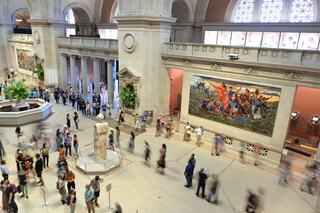
CHICAGO — On a recent afternoon outside the Art Institute of Chicago, there was no trace of the line that typically snakes down the museum’s granite steps and along Michigan Avenue as visitors wait to enter the grand home of Edward Hopper’s “Nighthawks” and Grant Wood’s “American Gothic.” Every so often a passer-by paused on the desolate sidewalk to take a selfie with one of the bronze lions guarding the museum, but there was no reason to go further: The doors were locked.
In New York, a strikingly different tableau was playing out on Fifth Avenue outside the Metropolitan Museum of Art. One of the front doors was propped open to welcome a steady stream of visitors; teenagers sat in chatty clusters on the front steps; couples and families paused for temperature checks before entering the bustling lobby.
The contrasting scenes illustrate the diverging approaches that cities, states and individual institutions have taken toward museumgoing at this stage of the pandemic. Museums in New York City, which is now reporting a higher positivity rate than Chicago, have been allowed to operate without interruption at reduced capacities since they reopened in August — while Chicago’s museums were forced into hibernation for two months starting in mid-November, only recently getting the green light to reopen.
Museums are open in Phoenix, where, per capita, the average number of new cases in the surrounding county over the last week has been more than twice as high as in Washington, where the museums of the Smithsonian Institution remain closed.
In Paris, the Louvre is closed, while in Madrid, the Prado is open.
The trend in the United States in recent weeks has tilted toward reopening. State and local officials have allowed museums in Boston, Chicago, Minneapolis, Philadelphia, Seattle and other cities to reopen again in some capacity, citing falling cases in their areas. The Art Institute of Chicago plans to reopen Feb. 11: officials are getting ready to remove the protective paper covering some of their Monets, calling furloughed employees back to work, and turning back on the lights that were extinguished to preserve the artwork.

 RSS Feed
RSS Feed